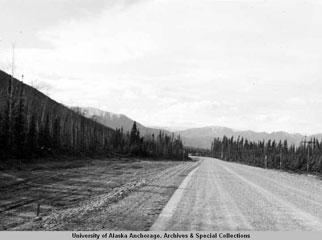The Alaska Highway was built in only eight months in 1942, following the need to connect the "Lower 48" and Alaska to provide for American defense after the bombing of Pearl Harbor. President Roosevelt authorized its construction, and soon the massive military road crew set off to complete the amazing feat of creating the Alaska Highway. The lack of communication the soldiers had with the outside world was a striking illustration of the remoteness of many of the communities prior to the completion of the highway. Located hundreds of miles from each other, communication between headquarters and field parties proved sometimes non-existent.
The Alaska Highway not only allowed for communication between the continental United States and Alaska, but it also physically linked cities and villages which previously had little connection except for sporadic trade along the trails and waterways. Suddenly a 1,390 mile road was completed, which not only linked communities to each other, but also served as the gateway north to the interior of Alaska, or south 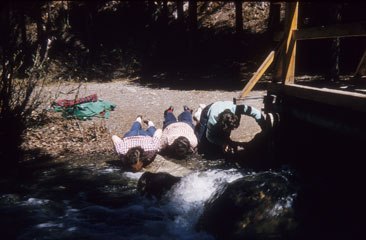 into Canada and the
into Canada and the
Lower 48. Today, the Alaska Highway is traveled for recreation, transportation to urban centers, and for shipping supplies.
The highway has affected the communities along its route positively and negatively. The highway has become a popular tourist attraction, which has created an influx of visitors to many of the communities. An increase of tourism can mean good business, a stronger economy, and a source of revenue that otherwise would not have existed. The simplicity and ease of driving the highway is also beneficial for the communities because of the accessibility to goods and services previously not available. Some feel a negative aspect of the highway is a loss of traditional culture because of outside influence, particularly in primarily Native communities (Coates, Kenneth. North to Alaska: Fifty years on the world’s most remarkable highway. Fairbanks, AK: University of Alaska Press, 1992).
Background
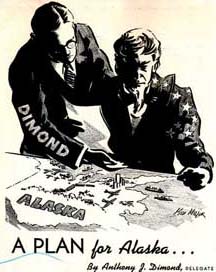
Proposals for a highway to Alaska had been discussed since the 1920s, but it took the crisis of World War II to make a viable land link to Alaska a reality.
On February 11, 1942, President Franklin D. Roosevelt authorized construction of a road to connect the airstrips along the Northwest Staging Route, a chain of airfields from Great Falls, Montana, through Canada, to Alaska used to ferry military aircraft. When the Japanese took control of shipping lanes in the Pacific, the American troops' supply line was threatened and a road to Alaska was considered the best alternative. On March 8, 1942, construction of the Alaska Highway officially began. Trailblazing was primarily completed by the U.S. Army, while civilian contractors followed them to widen and straighten the road. Completed in 1943, it is 2,237 kilometers or 1,522 miles long.
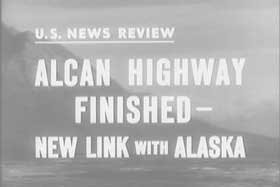 Since much of the route would pass through Canada, support from the Canadian government was crucial. However, the Canadian government perceived no value in putting up the required funds to build the road, since the only part of Canada that would benefit was not more than a few thousand people in the Yukon Territory. Canada agreed to allow construction as long as the United States bore the full cost, and that the road and other facilities in Canada would be turned over to Canadian authority after the war ended. There were five different routes proposed, and due to the imminence of war, and the bombing of Pearl Harbor, the choice had to be made quickly on the route. Time expediency and geographical considerations were also taken in account when choosing the fifth route, which is the present location of the highway.
Since much of the route would pass through Canada, support from the Canadian government was crucial. However, the Canadian government perceived no value in putting up the required funds to build the road, since the only part of Canada that would benefit was not more than a few thousand people in the Yukon Territory. Canada agreed to allow construction as long as the United States bore the full cost, and that the road and other facilities in Canada would be turned over to Canadian authority after the war ended. There were five different routes proposed, and due to the imminence of war, and the bombing of Pearl Harbor, the choice had to be made quickly on the route. Time expediency and geographical considerations were also taken in account when choosing the fifth route, which is the present location of the highway.
The Black Regiments Who Worked on the Highway - The 93rd, 95th and 97th
Three out of seven regimental units during World War II – the 93rd, 95th, and 97th - were enlisted Black men, making up one third (3,695) of all enlisted men building the Highway. Morale among Black troops tended to be low due to insufficient equipment and clothing, long tours of duty and lack of recognition by White officers and generals. Few Blacks had ever experienced northern wilderness living conditions such as those of the winter of 1942-1943, when record low temperatures reached -60 and -70 degrees Fahrenheit. In general, all military men were far less equipped, clothed and fed than civilian contractors, who continued to work during cold temperatures while the military units hibernated and tried to survive. Despite these hurdles, Black regiments constructed a large portion of the highway equal to standards of their White comrades. Fittingly, the last gap in the Alaska Highway was closed on October 25, 1942 with the meeting of a Black soldier from the 97th Regiment Engineers and a White soldier from the 18th Engineers, northwest of Kluane Lake, near the border of the Yukon Territory and Alaska. Former Lt. Alaska Governor Fran Ulmer stated, "Without the Black soldiers, the Alcan would likely never have been built in such a short time." (Society of Philatelic Events and Reflections.)
(Other information taken from The Alaskan Highway - A Yukon Perspective website)
Post WWII History
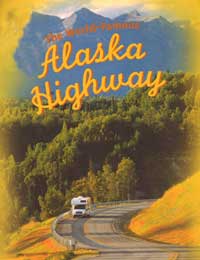
Six months after the end of World War II, the Alaska Highway was handed over to Canada on April 1, 1946. Paving of the highway began in the 1960s, but it was still primarily gravel into the 1980s. It was not until the mid-1980s that the highway was completely paved from Dawson Creek to Delta Junction.
The highway is now used primarily for travel, shipping freight, and tourism. Large amounts of freight and material goods are trucked up and down the highway, making it the most heavily used highway in the North. Travel prior to the highway had been via dog sled, on foot, by riverboat to train, and horse. The highway connects distant communities and allows easier travel to economic centers such as Whitehorse, Yukon or Tok, Alaska. Tourism became popular soon after the highway was opened to the public in 1948, and people from all over the United States, Canada and over-seas came to drive and experience the Alaska Highway.
Native Involvement with the Alaska Highway
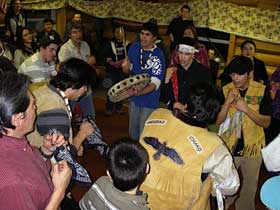
In the PBS special, "American Experience -- Building the Alaska Highway," historian Ken Coates described the effect of the Alaska Highway on the areas Native population: "Construction projects transformed aboriginal life in the northwest very quickly and very profoundly. There was only occasional work to be found, they didn't hire very many aboriginal people to work. The women got involved selling handicrafts and doing some domestic work... There were a lot of attacks on aboriginal people, some rapes of Native women, for example. A lot of misuse of alcohol with aboriginal people. So, a world had ended. A lifestyle that had been in place in many ways for centuries, but certainly since the arrival of the fur traders in the middle of the 19th century. It's a hundred years of fishing, and trapping, and sort of casual engagement with the market economy, poof, gone. Overnight."
Coates' description of the affect of the highway on the Native people is strikingly accurate. In their interviews, Laura Sanford, Charles Eikland and Babe Richards discuss the impact of the highway on First Nations and Alaska Natives in terms of religion, education, and traditional culture. They talk specifically about the misunderstandings between Natives and non-Natives, the loss of culture, residential schools and Native ways of life.


